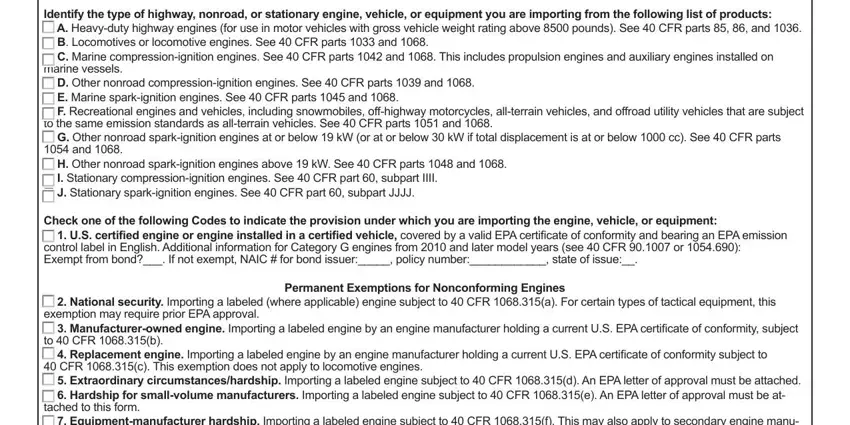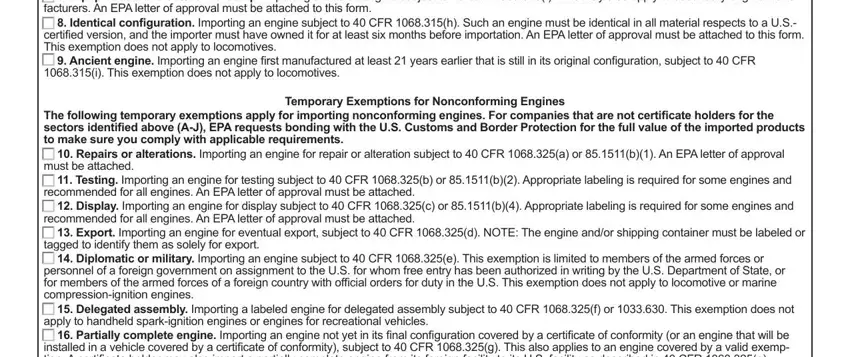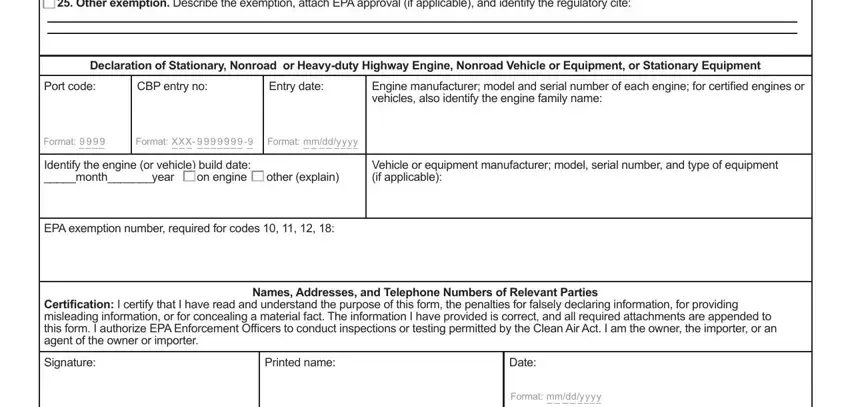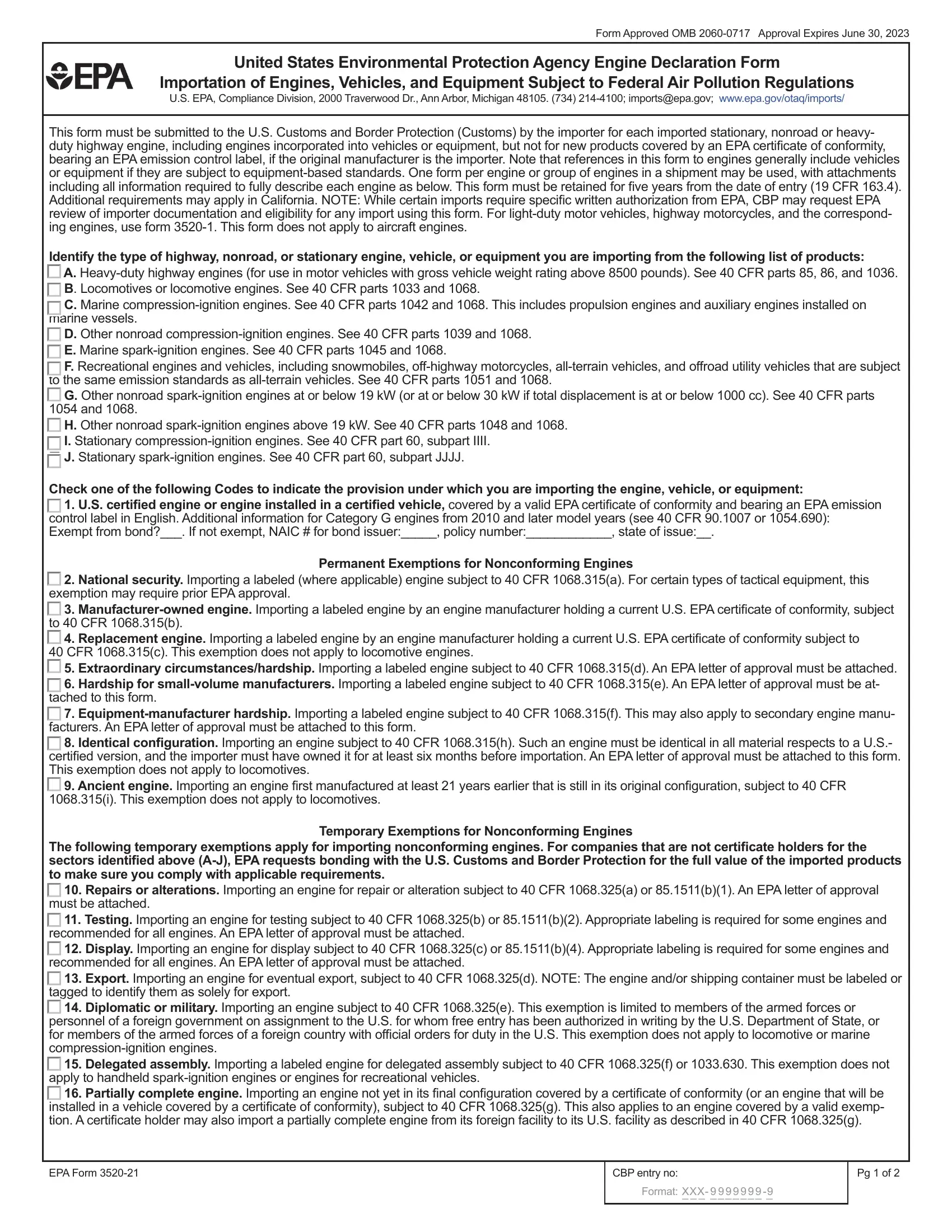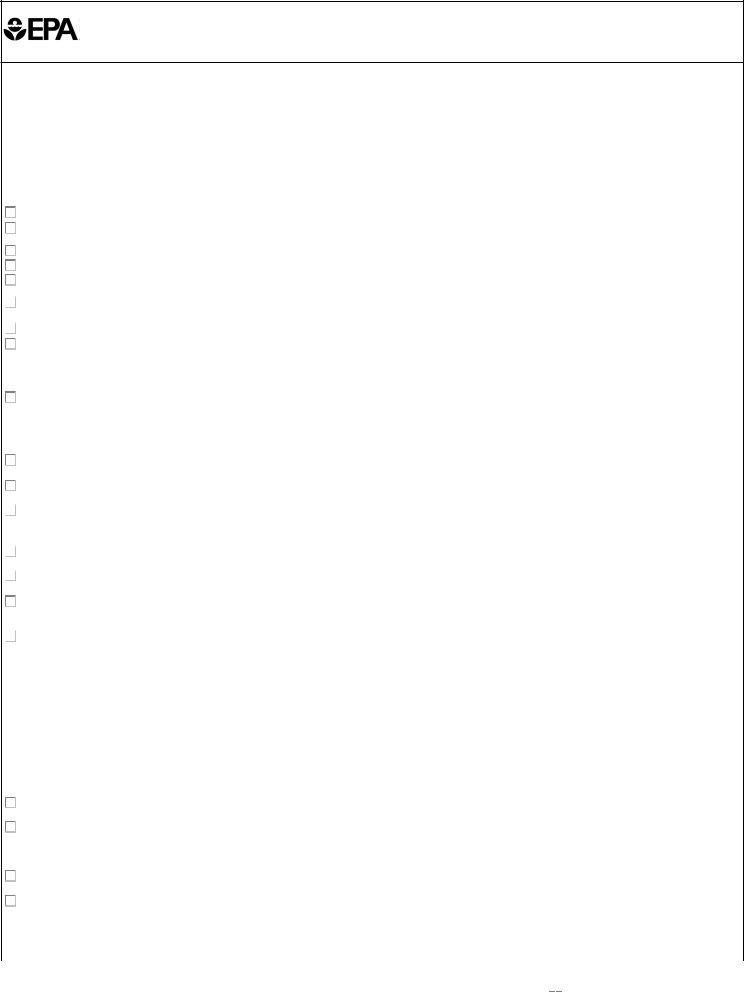Form Approved OMB 2060-0717 Approval Expires June 30, 2023
United States Environmental Protection Agency Engine Declaration Form &EPA Importation of Engines, Vehicles, and Equipment Subject to Federal Air Pollution Regulations
U.S. EPA, Compliance Division, 2000 Traverwood Dr., Ann Arbor, Michigan 48105. (734) 214-4100; imports@epa.gov; www.epa.gov/otaq/imports/
This form must be submitted to the U.S. Customs and Border Protection (Customs) by the importer for each imported stationary, nonroad or heavy- duty highway engine, including engines incorporated into vehicles or equipment, but not for new products covered by an EPA certificate of conformity, bearing an EPA emission control label, if the original manufacturer is the importer. Note that references in this form to engines generally include vehicles
or equipment if they are subject to equipment-based standards. One form per engine or group of engines in a shipment may be used, with attachments including all information required to fully describe each engine as below. This form must be retained for five years from the date of entry (19 CFR 163.4). Additional requirements may apply in California. NOTE: While certain imports require specific written authorization from EPA, CBP may request EPA review of importer documentation and eligibility for any import using this form. For light-duty motor vehicles, highway motorcycles, and the correspond- ing engines, use form 3520-1. This form does not apply to aircraft engines.
Identify the type of highway, nonroad, or stationary engine, vehicle, or equipment you are importing from the following list of products:
A. Heavy-duty highway engines (for use in motor vehicles with gross vehicle weight rating above 8500 pounds). See 40 CFR parts 85, 86, and 1036. B. Locomotives or locomotive engines. See 40 CFR parts 1033 and 1068.
C.Marine compression-ignition engines. See 40 CFR parts 1042 and 1068. This includes propulsion engines and auxiliary engines installed on marine vessels.
D. Other nonroad compression-ignition engines. See 40 CFR parts 1039 and 1068.
E.Marine spark-ignition engines. See 40 CFR parts 1045 and 1068.
F.Recreational engines and vehicles, including snowmobiles, off-highway motorcycles, all-terrain vehicles, and offroad utility vehicles that are subject to the same emission standards as all-terrain vehicles. See 40 CFR parts 1051 and 1068.
G. Other nonroad spark-ignition engines at or below 19 kW (or at or below 30 kW if total displacement is at or below 1000 cc). See 40 CFR parts 1054 and 1068.
H. Other nonroad spark-ignition engines above 19 kW. See 40 CFR parts 1048 and 1068.
I.Stationary compression-ignition engines. See 40 CFR part 60, subpart IIII. J. Stationary spark-ignition engines. See 40 CFR part 60, subpart JJJJ.
Check one of the following Codes to indicate the provision under which you are importing the engine, vehicle, or equipment:
1.U.S. certified engine or engine installed in a certified vehicle, covered by a valid EPA certificate of conformity and bearing an EPA emission control label in English. Additional information for Category G engines from 2010 and later model years (see 40 CFR 90.1007 or 1054.690):
Exempt from bond?___. If not exempt, NAIC # for bond issuer:_____, policy number:____________, state of issue:__.
Permanent Exemptions for Nonconforming Engines
2.National security. Importing a labeled (where applicable) engine subject to 40 CFR 1068.315(a). For certain types of tactical equipment, this exemption may require prior EPA approval.
3.Manufacturer-owned engine. Importing a labeled engine by an engine manufacturer holding a current U.S. EPA certificate of conformity, subject to 40 CFR 1068.315(b).
4. Replacement engine. Importing a labeled engine by an engine manufacturer holding a current U.S. EPA certificate of conformity subject to 40 CFR 1068.315(c). This exemption does not apply to locomotive engines.
5. Extraordinary circumstances/hardship. Importing a labeled engine subject to 40 CFR 1068.315(d). An EPA letter of approval must be attached.
6. Hardship for small-volume manufacturers. Importing a labeled engine subject to 40 CFR 1068.315(e). An EPA letter of approval must be at-
tached to this form.
7. Equipment-manufacturer hardship. Importing a labeled engine subject to 40 CFR 1068.315(f). This may also apply to secondary engine manu-
facturers. An EPA letter of approval must be attached to this form.
8.Identical configuration. Importing an engine subject to 40 CFR 1068.315(h). Such an engine must be identical in all material respects to a U.S.- certified version, and the importer must have owned it for at least six months before importation. An EPA letter of approval must be attached to this form. This exemption does not apply to locomotives.
9. Ancient engine. Importing an engine first manufactured at least 21 years earlier that is still in its original configuration, subject to 40 CFR 1068.315(i). This exemption does not apply to locomotives.
Temporary Exemptions for Nonconforming Engines
The following temporary exemptions apply for importing nonconforming engines. For companies that are not certificate holders for the sectors identified above (A-J), EPA requests bonding with the U.S. Customs and Border Protection for the full value of the imported products to make sure you comply with applicable requirements.
10. Repairs or alterations. Importing an engine for repair or alteration subject to 40 CFR 1068.325(a) or 85.1511(b)(1). An EPA letter of approval must be attached.
11. Testing. Importing an engine for testing subject to 40 CFR 1068.325(b) or 85.1511(b)(2). Appropriate labeling is required for some engines and recommended for all engines. An EPA letter of approval must be attached.
12. Display. Importing an engine for display subject to 40 CFR 1068.325(c) or 85.1511(b)(4). Appropriate labeling is required for some engines and recommended for all engines. An EPA letter of approval must be attached.
13.Export. Importing an engine for eventual export, subject to 40 CFR 1068.325(d). NOTE: The engine and/or shipping container must be labeled or tagged to identify them as solely for export.
14.Diplomatic or military. Importing an engine subject to 40 CFR 1068.325(e). This exemption is limited to members of the armed forces or personnel of a foreign government on assignment to the U.S. for whom free entry has been authorized in writing by the U.S. Department of State, or for members of the armed forces of a foreign country with official orders for duty in the U.S. This exemption does not apply to locomotive or marine compression-ignition engines.
15.Delegated assembly. Importing a labeled engine for delegated assembly subject to 40 CFR 1068.325(f) or 1033.630. This exemption does not apply to handheld spark-ignition engines or engines for recreational vehicles.
16.Partially complete engine. Importing an engine not yet in its final configuration covered by a certificate of conformity (or an engine that will be installed in a vehicle covered by a certificate of conformity), subject to 40 CFR 1068.325(g). This also applies to an engine covered by a valid exemp- tion. A certificate holder may also import a partially complete engine from its foreign facility to its U.S. facility as described in 40 CFR 1068.325(g).
EPA Form 3520-21 |
CBP entry no: |
_ |
|
Pg 1 of 2 |
|
I |
_ |
|
I |
|
|
Format: XXX- 9 9 9 9 9 9 9 -9 |
|
|
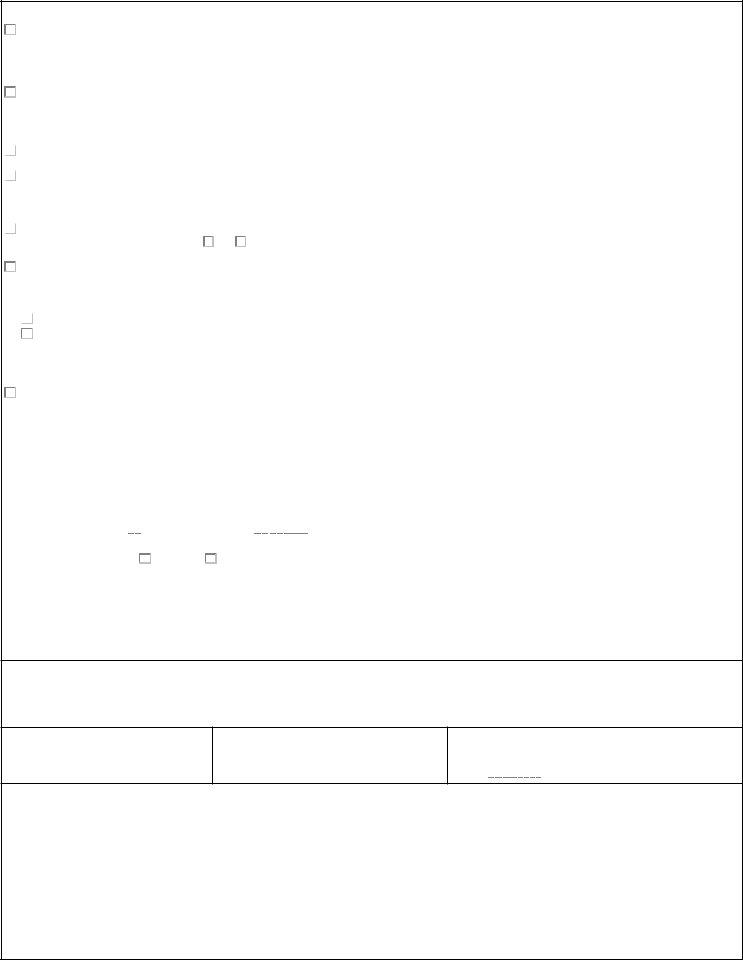
Importation of Engines Excluded from U.S. EPA Emission Standards
17.Engine manufactured before emission standards started to apply. These engines must generally have already been placed into service.
See the attached schedule. Note that 40 CFR 1068.360 disallows importation of new engines not certified to standards corresponding to the model year before the year of importation.
18. Competition engine. The engine must be used solely for competition, subject to 40 CFR 1068.310(a) or 85.1511(e). An EPA letter of approval
must be attached.
19.Stationary compression-ignition engine with displacement at or above 30 liters per cylinder or stationary spark-ignition engine above
19 kW that is not designed to run on gasoline or, if rich-burn, on liquified petroleum gas. These stationary engines are subject to EPA emission standards under 40 CFR part 60 Subparts IIII and JJJJ, but are not required to be certified. The engine must be used in a stationary manner. See 40 CFR 60.4219, 60.4248 and 1068.310(b). The engine must be labeled as described in 40 CFR 1039.20 or 1048.20, as applicable. NOTE: Stationary engines may be subject to state or local regulations.
20. Underground mining. Engine must be used in underground mining and regulated by the Mining Safety and Health Administration (MSHA). See 40 CFR 1039.5; see also 30 CFR parts 7, 31, 32, 36, 56, 57, 70, and 75. For compression-ignition engines only.
21. Hobby engine. Engine must be used to power a reduced-scale model of a vehicle not capable of transporting a person. See 40 CFR 1068.310(c).
Exemptions for Specific Engine Categories or Other Special Cases
22. Transition Program for Equipment Manufacturers. Importing a piece of equipment, subject to 40 CFR 1039.625 and 1039.626 (Category D). Maximum engine power: ____________ o kW o HP (or identify the regulatory power category). Exempt from bond?____. If not exempt, NAIC # for
bond issuer:____________, policy number:____________, state of issue:___.
23.Personal-use exemption for small spark-ignition engines. Importing three or fewer nonroad spark-ignition engines at or below 19 kW for purposes other than resale, where the importer has not used this exemption in the previous five years, subject to 40 CFR 1054.630.
24.Engine imported by an Independent Commercial Importer recognized by EPA. Only for Categories A and D above.
24a. For modification under an EPA certificate issued for the specific make, model, and model year under 40 CFR 85.1505, 89.605 or 1039.660. 24b. For modification and testing according to 40 CFR 85.1509. NOTE: The imported engine must be at least 6 years old.
|
|
|
|
|
24c. For precertification testing to obtain an EPA certificate under 40 CFR 85.1511(b)(3). NOTE: CBP bond is required. Specify location of storage |
|
|
|
|
|
|
(required for 24a and 24b): _________________________________________________________________________________________________ |
|
NOTE: Under 24a and 24b, you may import up to five highway engines in a given model year that are certified to standards based on an engine’s |
|
original production year. You may import any number of engines certified to standards that apply based on the year the engine is modified. See 40 CFR |
85.1503. |
|
|
|
|
|
|
|
|
|
|
|
25. Other exemption. Describe the exemption, attach EPA approval (if applicable), and identify the regulatory cite: |
|
|
|
|
|
|
|
|
|
|
|
|
|
|
|
|
|
|
|
|
|
|
|
|
|
|
|
|
|
|
|
|
|
|
|
|
|
|
|
|
|
|
|
|
|
|
|
Declaration of Stationary, Nonroad or Heavy-duty Highway Engine, Nonroad Vehicle or Equipment, or Stationary Equipment |
|
|
|
|
|
|
|
|
|
|
|
|
|
|
|
Port code: |
CBP entry no: |
|
|
Entry date: |
Engine manufacturer; model and serial number of each engine; for certified engines or |
|
|
|
|
|
|
|
|
|
|
|
|
vehicles, also identify the engine family name: |
|
Format: 9 9 9 9 |
Format: XXX- 9 9 9 9 9 9 9 -9 |
Format: mm/dd/yyyy |
|
|
|
|
|
|
|
|
_ |
|
_ |
|
|
|
|
Identify the engine (or vehicle) build date: |
Vehicle or equipment manufacturer; model, serial number, and type of equipment |
|
_____month_______year |
o |
on engine |
|
o |
other (explain) |
(if applicable): |
|
|
|
|
|
|
|
|
|
|
|
|
|
|
EPA exemption number, required for codes 10, 11, 12, 18:
Names, Addresses, and Telephone Numbers of Relevant Parties
Certification: I certify that I have read and understand the purpose of this form, the penalties for falsely declaring information, for providing misleading information, or for concealing a material fact. The information I have provided is correct, and all required attachments are appended to this form. I authorize EPA Enforcement Officers to conduct inspections or testing permitted by the Clean Air Act. I am the owner, the importer, or an agent of the owner or importer.
Identify the name, address, phone number, and e-mail address for the importer, broker, and owner as applicable:
Importer (required): |
Broker (optional): |
Owner (optional): |
|
|
|

Penalties: (1) Anyone who knowingly makes any false or fraudulent statement, or omits or conceals a material fact can be fined up to $320,000 or imprisoned for up to 5 years, or both (18 U.S.C. 1001). Anyone who illegally imports an engine may be fined up to $44,539 per engine (42 U.S.C. 7524), and may be subject to forfeiture of the entire importation bond, if applicable (40 CFR 1068.335) and the engine is subject to seizure by CBP (19 CFR 162.21). (2) Anyone who distributes in commerce, sells, offers for sale, or introduces into commerce an engine subject to EPA certification requirements but not covered by a certificate of conformity, may be fined up to $44,539 per engine (40 CFR 1068.101(a). (3) Any person who circumvents or attempts to circumvent residence-time requirements for stationary engines may be fined up to $44,539 per engine or piece of equipment (40 CFR 1068.101(b)(3)). Paperwork Reduction Act Notice: This information is collected to ensure that engines imported into the U.S. conform with applicable emission requirements. Responses to this collection are mandatory (Clean Air Act sections 202, 203, and 208). Information submitted to the Agency under a claim of confidentiality will be safeguarded as described in 40 CFR part 2. The public reporting and recordkeeping burden for this collection of information is estimated to average 30 minutes per response. An agency may not conduct or sponsor, and a person is not required to respond to, a collection of information unless it displays a currently valid OMB control number. Send comments on the Agency's need for this information, the accuracy of the provided burden estimates, and any suggested methods for minimizing respondent burden, including through the use of automated collection techniques to the Director, Collection Strategies Division, U.S. Environmental Protection Agency (2822), 1200 Pennsylvania Ave., NW, Washington, DC 20460. Include the OMB control number in any correspondence. Do not send the completed form to this address.
Schedule for Application of New Emission Standards for Certifying Engines and Vehicles
|
Engine category |
Engine subcategory |
Manufacturing date after which |
|
|
|
EPA certification is first required |
|
A. Heavy-duty highway engines |
— |
Model year 1970 |
|
|
|
|
|
B. Locomotives or locomotive engines |
— |
January 1, 1973 |
|
|
|
|
|
C. Marine compression-ignition engines at or |
Commercial: displacement < 0.9 L/cyl |
Model year 2005 |
|
above 37 kW |
|
|
|
Commercial: 0.9 < displacement < 2.5 L/cyl |
Model year 2004 |
|
|
|
|
|
|
|
|
Commercial: displacement > 2.5 L/cyl |
Model year 2004 |
|
|
|
|
|
|
Recreational: displacement < 0.9 L/cyl |
Model year 2007 |
|
|
|
|
|
|
Recreational: 0.9 < displacement < 2.5 L/cyl |
Model year 2006 |
|
|
|
|
|
|
Recreational: displacement > = 2.5 L/cyl |
Model year 2004 |
|
|
|
|
|
D. Other nonroad compression-ignition engines. |
Marine compression-ignition engines: Power < 19 kW |
January 1, 2000 |
|
|
|
|
|
|
Marine compression-ignition engines: 19 kW < Power < 37 |
Model year 1999 |
|
|
|
|
|
|
Nonroad engines: Power < 19 kW |
January 1, 2000 |
|
|
|
|
|
|
Nonroad engines: 19 kW < Power < 37 |
January 1, 1999 |
|
|
|
|
|
|
Nonroad engines: 37 kW < Power < 75 |
January 1, 1998 |
|
|
|
|
|
|
Nonroad engines: 75 kW < Power < 130 |
January 1, 1997 |
|
|
|
|
|
|
Nonroad engines: 130 kW < Power < 560 |
January 1, 1996 |
|
|
|
|
|
|
Nonroad engines: Power > 560 kW |
January 1, 2000 |
|
|
|
|
|
E. Marine spark-ignition engines. |
Outboard |
Model year 1998 |
|
|
|
|
|
|
Personal watercraft |
Model year 1999 |
|
|
|
|
|
|
Sterndrive/inboard |
Model year 2010 |
|
|
|
|
|
F. Recreational spark-ignition engines and |
— |
Model year 2006 |
|
vehicles |
|
|
|
|
|
|
|
G. Other nonroad spark-ignition engines at or |
— |
Model year 1997 |
|
below 19 kW |
|
|
|
|
|
|
|
H. Other nonroad spark-ignition engines above |
— |
Model year 2004 |
|
19 kW |
|
|
|
|
|
|
|
I. Stationary compression-ignition engines |
— |
April 1, 2006 |
|
|
|
|
|
J. Stationary spark-ignition engines |
All engines with maximum engine power < 19 kW |
July 1, 2008 |
|
|
Non-emergency engines with maximum engine power between 19 |
|
|
|
and 373 kW |
|
|
|
|
|
|
|
Non-emergency engines with maximum engine power > 373 kW |
July 1, 2007 |
|
|
|
|
|
|
Emergency engines with maximum engine power > 19 kW |
January 1, 2009 |
